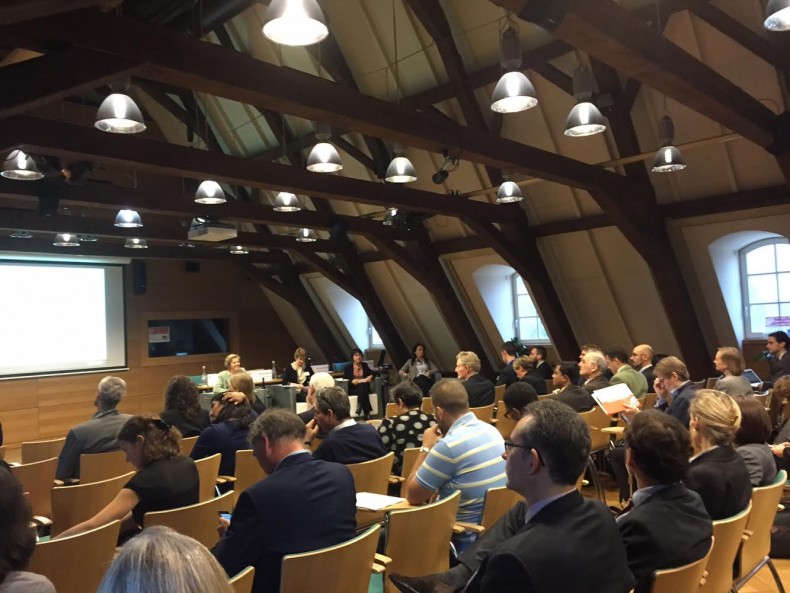Opening Session of European Microfinance Weeks Asks if Financial Inclusion, Stability and Client Protection can Co-Exist
Financial Inclusion has long since become the dominant discourse in providing financial services to under-served populations – something which used to be called ‘microfinance’, and before that just plain ‘microcredit’. Inclusion (or ‘Inclusive Finance’, as is voguish) means different things to different stakeholders, but “the provision of quality financial services to those previously excluded from the financial services sector” is probably acceptable to most.
But is it costly? Or rather, is the key “quality” element something that is irreconcilable with commercial goals, because of the burdens its provision places on institutions, or the adverse affect it can have on market stability? Put another way, is client protection, in all its forms, in opposition to financial inclusion (in that it prevents vulnerable populations being reached), and can market stability be possible if attention and resources are devoted to client protection at the expense of growth, profitability and scale?
“Balancing Financial Inclusion, Market Stability and Client Protection” was the topic for the kick-off plenary at EMW2014. After an introduction by Scott Brown, CEO of Vision Fund and part of the Microfinance CEO Working Group (eight CEOs of international MFIs, covering 45 million clients in 70 countries, and working for advocacy, and industry and institutional strengthening), Antonique Koning from CGAP kicked off a wide-ranging panel debate.
Antonique heads up CGAP’s workstream on customer empowerment, balancing, as she put it, “financial inclusion (I), financial stability (S), financial integrity (I), and financial consumer protection (P) (collectively I-SIP)”. Narda Sotomayor represents SBS Peru, the country’s Superintendency – the banking regulator. From a financially excluded background herself, she returned from overseas doctoral study to lead research on changes in regulation, and the impact it has on institutions and clients.
Armenuhi Mkrtchyan represents the Armenian Central Bank. As she tells it, for ten years, they set up the infrastructure that could be envisioned to strengthen the supply side of the microfinance market. Credit bureaus, deposit insurance, joint regulatory bodies. “Everything to make investors feel secure”, she says. But in 2006, she and her colleagues realised that this just wasn't enough to achieve “deep inclusion”. Why? Because the customers don’t understand finance, and credit in particular. This meant strengthening the demand side through consumer protection and financial education.
Kim Wilson is a Lecturer in International Business and Human Security at the Fletcher School at Tufts University in the US. As a teenager, she says, she was “a child of credit”, working summer holidays for her retailer father to repossess furniture and appliances from defaulting customers. Ten years ago, she found herself as Director of the Global Microfinance Unit at Catholic Relief Services. “We didn’t have any impact assessment or smart understanding of what we were affecting – just lots of hunches, lots of problems among 35 programs, some of which were fully functional but some were plainly non sustainable NGOs.
What she came to feel, she says, was that they were clashing against what they were actually supposed to be doing, because it’s difficult to see all the consequences of every action. Microenterprises were serving as fronts for money laundering, for example. So she left that position, “hid” at university, and was approached by Gates Foundation to launch the Fletcher leadership course – two matriculators of which are Armenuhi Mkrtchyan and Narda Sotomayor, alongside her today.
So, a central banker, a regulator and a practitioner/academic: a range of experience in how to find the products, mechanisms and regulation to maximise market stability, reach excluded populations, and ensure those clients are adequately protected. What does the audience think, asked Antonique Koning, who moved on to put three statements up for a show of hands and discussion.
“There is no trade-off between financial education and financial stability” was the first – with the audience roughly split 50:50. The question is an unusual one – maybe “It is possible to reconcile provision of financial education and market stability” would've yielded richer responses. One audience member argued in favour of the original statement, arguing that investment in education ultimately pays off in stability.
The second statement up for discussion was this: “By definition, financial inclusion implies consumer protection”. The trouble here (and the explanation for the audience’s reluctance to commit either way) is that there’s a disconnect between theory and practice. Perhaps most people in the audience agreed with one member, who said that, yes, genuine inclusion needs to incorporate consumer protection, because otherwise all we’re talking about is financial access; inclusion has to mean more. “Financial inclusion means quality financial services, and they cannot be quality if consumers aren’t protected”, goes the argument.
But in practice, consumer protection isn’t given the attention it needs in promoting inclusion – although no doubt this is generally improving. The third statement garnered an almost unanimous response, because it’s virtually axiomatic: “Financial education is an essential part of consumer protection”. This is so clear it hardly bears analysis.
So, it’s clear that protection, inclusion and stability aren’t ‘zero-sum’. There are synergies to be found. Narda’s focus at SBS Peru is primarily market stability. This means, in practice, “generating the incentives such that financial institutions can develop their own consumer protection initiatives”. Put another way, creating the environment where it’s in the institution’s interest to protect, rather than exploit, the customer. Consumer protection, she says, comes mainly through transparency. A consumer who is well informed about a financial product’s characteristics, including the terms and the risks is in better position to make good decisions, manage risks and understand and meet his or her own obligations. “This is win-win for the client, the institution, and the sector”, she says.
For Armenuhi, synergy comes a different route. “In policy, this balance, or synergy, comes about because when people are excluded, this poses threats to financial stability and integrity”. What is financial integrity? Absence of money laundering is one factor, reduced flows in opaque, shadow banking channels. To what extent this is an issue peculiar to certain markets like Armenia, or something that is inherent in all developing markets, was left undiscussed.
Caps on interest rates, whether by design or accident, dominated the rest of the session. All the speakers are opposed to caps – as were, from the questions, almost all the audience. After all, when policy makers want to cap rates and do it effectively, they need to have the knowledge of what the caps should be. “Nobody can do this better than the market”, argued Armenuhi.
Narla cited her home country of Peru, which went through a well-intentioned experiment in interest rate caps last decade, but with “totally unexpected results”…we ended up damaging those people we wanted to benefit – those in the bottom quartile”. Higher socio-economic segments benefitted, she said, because cheaper credit gives incentives to corruption (and presumably higher socio-economic segments benefit more from corruption). Moreover, market stability mandates sustainability, which means institutions need to be able to cover all their costs. Binding rates are anathema to this. Ultimately, a market with fair competition should take care of it, and push rates down.
Kim cited interest rate caps in certain US states, especially on payday lenders. “Credit is heroin”, and people get into a dependency on usurious credit. But she defended caps in this case, because payday lenders (as they do in the UK as well) charge 3 or even 4-digit interest rates – orders of magnitude above their costs, and the caps in place were still high enough that anyone could sustain a business by charging within those limits.
Intervening always has its costs. Armenuhi says that in the long term, they’ve found that in Armenia, setting rates is more costly than subsidising vulnerable groups. Narda points to how Peru has now reached its position as the highest rated microfinance market (as recently re-affirmed in the 2014 EIU MicroScope). But policy-makers must remain vigilant. As banks downscale, MFIs are motivated to go and find harder-to-reach markets, and their portfolios change as new, previous excluded people are brought in. A credit portfolio can deteriorate quickly unless the methodology is still appropriate for the new customers, she says. “The process of lending isn't static; it’s very dynamic – and creating a close relationship with demand side is very important.”
“Go downmarket, but adapt – or risk destabilising and affecting customers”.
Kim finished with a positive story – a morality tale for how to find this elusive balance:
“A few years ago, I was in Tajikistan, and kept coming across these ‘ExpressPay” kiosks, where people pay their utility bills and other things. Then, I found out that the network had been closed down. I met the CEO. The regulator had shut him down, but said the following: ‘ if you work with me to meet our requirements, in three months you’ll be licensed, you can re-open, and you’ll even be able to store funds’. True to form, three months later, ExpressPay reopened, fully licensed to take payments and also to hold funds – providing a range of new business opportunities to the company, and services to the customers.”
“ExpressPay reopened because there was a great regulator at the Central bank, who understood the key elements of stability, protection and inclusion, and knew that with some adaptation and buy-in from the CEO, all three could be achieved. The lesson is that regulators are human beings too”.



Leave a comment